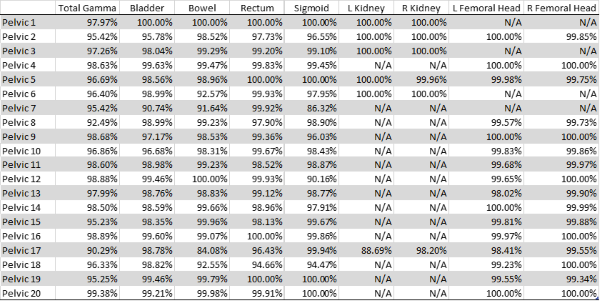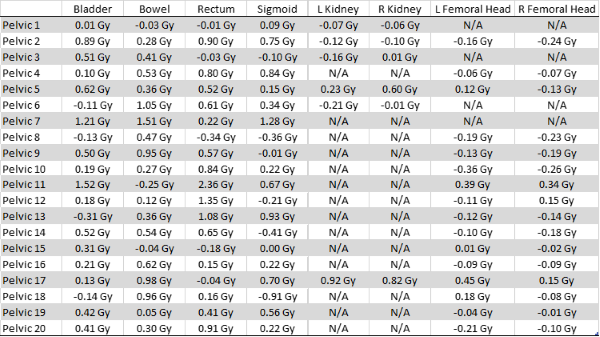3D dose calculation verification in light of AAPM TG219 recommendations for pelvis cancer patients
PO-1582
Abstract
3D dose calculation verification in light of AAPM TG219 recommendations for pelvis cancer patients
Authors: Madison Naessig1, Kathryn Kelly1, Alyssa Alvarez1, Mohamad Fakhreddine1, Sotirios Stathakis1
1University of Texas Health Science Center at San Antonio, Radiation Oncology, San Antonio, USA
Show Affiliations
Hide Affiliations
Purpose or Objective
To
assess the gamma index for the total treatment volume and various organs at
risk (OARs) as well as the mean dose difference by using a secondary system, PTW
VERIQA, that performs an independent Monte Carlo 3D dose calculation. At this
time, gamma indices are evaluated for an overall delivery of a patient plan or
in some cases for PTV volumes. However, VERIQA provides an expanded review of
one’s gamma analyses by having the ability to evaluate specific OARs.
Material and Methods
Twenty
pelvic treatment plans were exported from the Pinnacle Treatment Planning
System to VERIQA. The gamma analysis was performed for each patient plan at
3%/2mm with a low-dose threshold of 10% of the maximum compared dose. The gamma
index for the total volume encompassed within the external contour was recorded
along with the gamma index for the bladder, bowel, rectum, sigmoid, femoral
heads, and kidney when applicable. The mean dose difference for the previously
stated OARs were also noted for comparison purposes.
Results
The
total volume of each pelvic treatment plan had at least 90% of all voxels
passing at a gamma rate of less than one at 3%/2mm. The bladder had a range of
gamma indices from 90.74% to 100.00% with an average gamma index of 98.23%. The
mean dose difference between Pinnacle and VERIQA was recorded for the bladder
and demonstrated an absolute average difference of 0.421 Gy, whereas the bowel
showed an absolute average difference of 0.504 Gy. The bowel had one failing
gamma index at 84.08%, while the other 19 pelvic plans had an average passing gamma
index of 98.19% for the bowel. A correlation was observed between the failing
gamma index for the bowel and a nearly failing total volume gamma index of
90.29% for that specific plan. The sigmoid and left kidney were the only other
OARs with a single failing gamma index of 86.32% and 88.69% out of the twenty
pelvic treatment plans. The femoral heads exhibited high passing gamma indices
compared to the other OARs with a range of 98.02% to 100.00% and an average of 99.74%.


Conclusion
VERIQA
can be used as another assessment tool to help understand total volume gamma passing
or failing rates by considering OAR gamma indices and their potential impact. VERIQA
provides a more thorough evaluation of the delivery of the treatment plan and
allows you to better evaluate dose to critical structures, which can be
beneficial in cases where a structure is near a PTV or has previously received
radiation.